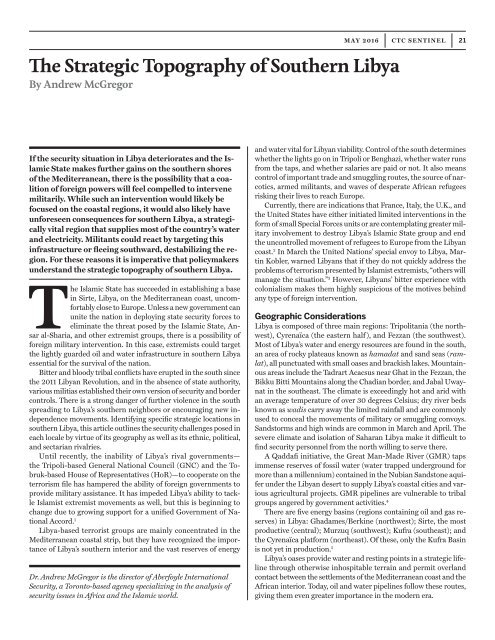The Challenges of Explosive Detection
CTC-SENTINEL_Vol9Iss58
CTC-SENTINEL_Vol9Iss58
Create successful ePaper yourself
Turn your PDF publications into a flip-book with our unique Google optimized e-Paper software.
<strong>The</strong> Strategic Topography <strong>of</strong> Southern Libya<br />
By Andrew McGregor<br />
MAY 2016 CTC SENTINEL 21<br />
If the security situation in Libya deteriorates and the Islamic<br />
State makes further gains on the southern shores<br />
<strong>of</strong> the Mediterranean, there is the possibility that a coalition<br />
<strong>of</strong> foreign powers will feel compelled to intervene<br />
militarily. While such an intervention would likely be<br />
focused on the coastal regions, it would also likely have<br />
unforeseen consequences for southern Libya, a strategically<br />
vital region that supplies most <strong>of</strong> the country’s water<br />
and electricity. Militants could react by targeting this<br />
infrastructure or fleeing southward, destabilizing the region.<br />
For these reasons it is imperative that policymakers<br />
understand the strategic topography <strong>of</strong> southern Libya.<br />
<strong>The</strong> Islamic State has succeeded in establishing a base<br />
in Sirte, Libya, on the Mediterranean coast, uncomfortably<br />
close to Europe. Unless a new government can<br />
unite the nation in deploying state security forces to<br />
eliminate the threat posed by the Islamic State, Ansar<br />
al-Sharia, and other extremist groups, there is a possibility <strong>of</strong><br />
foreign military intervention. In this case, extremists could target<br />
the lightly guarded oil and water infrastructure in southern Libya<br />
essential for the survival <strong>of</strong> the nation.<br />
Bitter and bloody tribal conflicts have erupted in the south since<br />
the 2011 Libyan Revolution, and in the absence <strong>of</strong> state authority,<br />
various militias established their own version <strong>of</strong> security and border<br />
controls. <strong>The</strong>re is a strong danger <strong>of</strong> further violence in the south<br />
spreading to Libya’s southern neighbors or encouraging new independence<br />
movements. Identifying specific strategic locations in<br />
southern Libya, this article outlines the security challenges posed in<br />
each locale by virtue <strong>of</strong> its geography as well as its ethnic, political,<br />
and sectarian rivalries.<br />
Until recently, the inability <strong>of</strong> Libya’s rival governments—<br />
the Tripoli-based General National Council (GNC) and the Tobruk-based<br />
House <strong>of</strong> Representatives (HoR)—to cooperate on the<br />
terrorism file has hampered the ability <strong>of</strong> foreign governments to<br />
provide military assistance. It has impeded Libya’s ability to tackle<br />
Islamist extremist movements as well, but this is beginning to<br />
change due to growing support for a unified Government <strong>of</strong> National<br />
Accord. 1<br />
Libya-based terrorist groups are mainly concentrated in the<br />
Mediterranean coastal strip, but they have recognized the importance<br />
<strong>of</strong> Libya’s southern interior and the vast reserves <strong>of</strong> energy<br />
Dr. Andrew McGregor is the director <strong>of</strong> Aberfoyle International<br />
Security, a Toronto-based agency specializing in the analysis <strong>of</strong><br />
security issues in Africa and the Islamic world.<br />
and water vital for Libyan viability. Control <strong>of</strong> the south determines<br />
whether the lights go on in Tripoli or Benghazi, whether water runs<br />
from the taps, and whether salaries are paid or not. It also means<br />
control <strong>of</strong> important trade and smuggling routes, the source <strong>of</strong> narcotics,<br />
armed militants, and waves <strong>of</strong> desperate African refugees<br />
risking their lives to reach Europe.<br />
Currently, there are indications that France, Italy, the U.K., and<br />
the United States have either initiated limited interventions in the<br />
form <strong>of</strong> small Special Forces units or are contemplating greater military<br />
involvement to destroy Libya’s Islamic State group and end<br />
the uncontrolled movement <strong>of</strong> refugees to Europe from the Libyan<br />
coast. 2 In March the United Nations’ special envoy to Libya, Martin<br />
Kobler, warned Libyans that if they do not quickly address the<br />
problems <strong>of</strong> terrorism presented by Islamist extremists, “others will<br />
manage the situation.” 3 However, Libyans’ bitter experience with<br />
colonialism makes them highly suspicious <strong>of</strong> the motives behind<br />
any type <strong>of</strong> foreign intervention.<br />
Geographic Considerations<br />
Libya is composed <strong>of</strong> three main regions: Tripolitania (the northwest),<br />
Cyrenaïca (the eastern half), and Fezzan (the southwest).<br />
Most <strong>of</strong> Libya’s water and energy resources are found in the south,<br />
an area <strong>of</strong> rocky plateaus known as hamadat and sand seas (ramlat),<br />
all punctuated with small oases and brackish lakes. Mountainous<br />
areas include the Tadrart Acacsus near Ghat in the Fezzan, the<br />
Bikku Bitti Mountains along the Chadian border, and Jabal Uwaynat<br />
in the southeast. <strong>The</strong> climate is exceedingly hot and arid with<br />
an average temperature <strong>of</strong> over 30 degrees Celsius; dry river beds<br />
known as wadis carry away the limited rainfall and are commonly<br />
used to conceal the movements <strong>of</strong> military or smuggling convoys.<br />
Sandstorms and high winds are common in March and April. <strong>The</strong><br />
severe climate and isolation <strong>of</strong> Saharan Libya make it difficult to<br />
find security personnel from the north willing to serve there.<br />
A Qaddafi initiative, the Great Man-Made River (GMR) taps<br />
immense reserves <strong>of</strong> fossil water (water trapped underground for<br />
more than a millennium) contained in the Nubian Sandstone aquifer<br />
under the Libyan desert to supply Libya’s coastal cities and various<br />
agricultural projects. GMR pipelines are vulnerable to tribal<br />
groups angered by government activities. 4<br />
<strong>The</strong>re are five energy basins (regions containing oil and gas reserves)<br />
in Libya: Ghadames/Berkine (northwest); Sirte, the most<br />
productive (central); Murzuq (southwest); Kufra (southeast); and<br />
the Cyrenaïca platform (northeast). Of these, only the Kufra Basin<br />
is not yet in production. 5<br />
Libya’s oases provide water and resting points in a strategic lifeline<br />
through otherwise inhospitable terrain and permit overland<br />
contact between the settlements <strong>of</strong> the Mediterranean coast and the<br />
African interior. Today, oil and water pipelines follow these routes,<br />
giving them even greater importance in the modern era.


